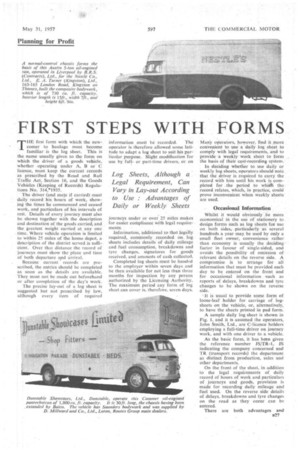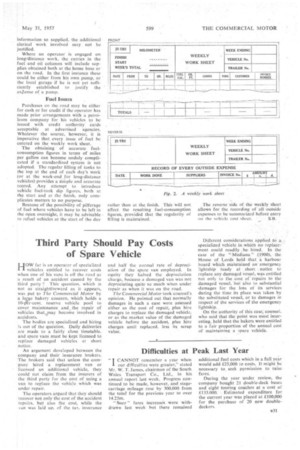FIRST STEPS WITH FORMS
Page 61

Page 62

Page 65

If you've noticed an error in this article please click here to report it so we can fix it.
Log Sheets, Although a Legal Requirement, Can Vary in Lay-out According to Use : Advantages of Daily or Weekly Sheets
THE first form with which the newcorner to haulage roust become familiar is the log sheet. This is the name usually given to the form on which the driver of a goods vehicle, whether operating under A, B or C licence, must keep the current records as prescribed by the Road and Rail Traffic Act, Section 16, and the Goods Vehicles (Keeping of Records) Regulations No. 31471935.
The driver (and mate if carried) must daily record his hours of work, showing the times he commenced and ceased work, and particulars of his intervals of rest. Details of every journey must also be shown together with the description and destination of the goods carried, and the greatest weight carried at any one lime. Where vehicle operation is limited to within 25 miles of the home depot, a description of the district served is sufficient. Over that distance the record of journeys must show the place and time of both departure apci arrival. Because current records are prescribed, the entries should be completed as soon as the details are available. They must not be made out beforehand or after completion of the day's work.
The precise lay-out of a log sheet is suggested but not prescribed by law, although every item of required information must be recorded. The operator is therefore allowed some latitude to adapt a log sheet to suit his parlicular Slight modification for use by fullor part-time drivers, or on journeys under or over 25 miles makes for easier coMpliance with legal require ments. •
Information, additional to that legally required,, commonly, .recorded on log sheets includes details of daily mileage and fuel consumption, breakdowns and Lyre changes, signatures for goods. received, and amounts of cash collected.
Completed log sheets must be handed to the employer within seven days and be then available for not less than three months for inspection by any person authorized by the Licensing Authority. The maximum period any form of log sheet can cover is, therefcire, seven days. Many operators, however, find it more convenient to use a daily log sheet to comply with legal requirements, and to provide a Weekly work sheet to form the basis of their cost-recording system.
Iii deciding whether to use daily or weekly log sheets, operators should note that the driver is required to carry the redord with him until his work is completed for .the period to whieh the record relates, which, in practice, could prove inconvenient when weekly sheets Ore used.
Occasional Information Whilst it would obviously be more economical in the use of stationery to design forms such as log sheets for use on both sides; particularly as several hundreds a year may. be used by only a small fleet owner, convenience rather than economy is usually the deciding factor in favour of single-sided, and avoids the possibility of omission of relevant details on the reverse side. A compromise is to arrange for all information that must be provided each day to be entered on the front and for occasional information such as reports of delays, breakdowns and tyre changes to be shown on the reverse side.
It is usual to provide some form of -loose-leaf holder for carriage of logsheets on the vehicle, or, alternatively, to have the sheets printed in pad form.
A sample daily log sheet is shown in Fig. 1, and it is assumed the operators, John Smith, Ltd., are C-licence holders employing a full-time driver on journey work, and with one driver to a vehicle.
As the basic form, it has been given the reference number fSiTR-1, JS indicating the company concerned and TR (transport records) the department as distinct from production, sales and other departments.
On the front of the sheet, in addition to the legal requirements of daily record of hours of work and particulars of journeys and goods, provision is made for recording daily mileage and fuel used. On the reverse side details of delays, breakdowns and tyre changes on the road as they occur can be entered.
There are both advantages and disadvantages in suggesting the form a weekly work sheet should take. The advantage, compared with a log sheet, is that it is not determined in any way by legal requirements. But precisely because it should be adapted exactly to the needs of each individual operator if is to be of the maximum use and convenience, there can be no standard form ideal to all users.
It should, however, be remembered that the purpose of a weekly work sheet is to provide a convenient link between the daily log sheet and the all-important individual vehicle cost sheet. It follows therefore that the work of transferring this information will be reduced if the various items are kept in the same order as far as possible on all three sheets.
Whilst in some instances, as already mentioned. it may be possible to use a weekly log sheet (as distinct from .a daily sheet), in all other eases it is necessary to summarize the data from the daily log sheets into weekly totals before entry on to the cost sheet, and a weekly work sheet is usually found to be a convenient method.
Another factor relating to the use ol weekly work sheets is whether the one driver-one vehicle policy applies or not. If so, the sheet could conveniently be completed by the driver himself, as in the case of the owner-driver. Whilst admittedly this can still be done where more than one driver is detailed to a vehicle, more supervision would probably be required to ensure that all relevant details were duly entered.
The lay-out of the weekly work sheet shown in Fig. 2 is given as an example, and would vary accordingly to the type of traffic carried. But information as to mileage, fuel and oil consumption must be recorded. The last two columns headed " Customer " and "Invoice No.," following a description of the goods and tonnage carried would ensure that all work performed is duly charged, the word " Department " being substituted for " Customer " in the case of a C-licence operator.
Recording the weekly mileage as shown by the milometer, comparing it with the total of the journey mileages, will draw attention to the omission of any trips or mileage otherwise unaccounted for.
Some operators may prefer to divide the mileage column to show both empty and loaded mileage and so pin-point less remunerative journeys. But unless positive action can be taken on the information so supplied, the additional clerical work involved may not be justified.
Where an operator is engaged on long-distance work, the entries in the fuel and oil columns will include supplies obtained both at the home base or on the road, In the first instance the could be either from his own pump, or the local garage if he is not yet sufficiently established to justify the exense of a pump.
Fuel Issues Purchases on the road may be either for cash or for credit if the operator has made prior arrangements with a petrOteam company for his vehicles to be issued with credit authority, cards acceptable at advertised agencies. Whatever the source, however, it is imperative that every issue of. fuel he entered on the weekly work sheet.
The obtaining of accurate fuelconsumption figures in terms of miles per gallon can become unduly complicated if a standardized system is not adopted. The regular filling oE tanks to the top at the end of each day's work (or at the week-end for long-distance vehicles) provides a simple and accurate record. Any attempt to introduce vehicle fuel-tank dip figures, both at the start and at the finish, only complicates matters to no purpose.
Because of the possibility of pilferage of fuel where vehicles have to be left in Ihe open overnight, it may be advisable to refuel vehicles at the start of the day rather than at the finish. This will not affect the resulting fuel-consumption figures, provided that the regularity of filling is maintained.,
The reverse 'side of the weekly •sheet allows for the recording of -all •outside expenses to be summarized before entry on the vehicle cosi sheet. • S.B.




































































































